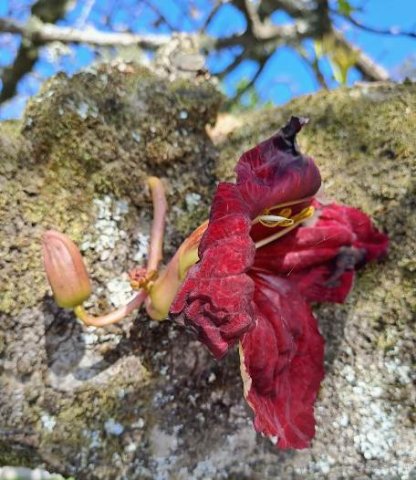Kigelia africana flowering on old stem

Author: Ivan Lätti
Photographer: Francelle van Zyl
A Kigelia africana inflorescence may grow directly from an old stem as seen here. The phenomenon is called cauliflory, the growth of flowers and fruit directly from old woody trunks. (This makes one revisit the nature of the cauliflower. Although the word roots both refer to stem and flower, that is, however, where the similarity ends.)
The capacity called cauliflory allows floral access to pollinators differently endowed to those normally servicing stem-tip flowers. Like maybe some creepy-crawly insects or bats, whatever gets turned on by the rather foul smell of the flowers. (Bats are thought to be related to K. africana pollination.) The positions from which these inflorescences emerge on old wood are probably the vestiges of leaf axils from many years ago, remnants of once active nodes supporting leaves. As leaves disappear and bark thickens, some of these nodes may retain the capability of producing flowers and fruits, although by now out of the leaving business.
Apart from an open flower in picture, in a range of velvety maroon shades and varied textures reminding of elephant skin, there is a bullet-shaped, striped bud on a fleshy, pale pedicel. But look, there is more!
Between flower and bud there is a bunch of to be developed buds that will hang lower in the extending inflorescence in due course, used should the first attempts at fertilisation fail. Mother nature can be motherly and provide abundance for the avoidance of reproductive disappointment. That is her life-giving forte, after all (Leistner, (Ed.), 2000; iNaturalist; https://antropocene.it; https://treesa.org/kigelia-africana).

